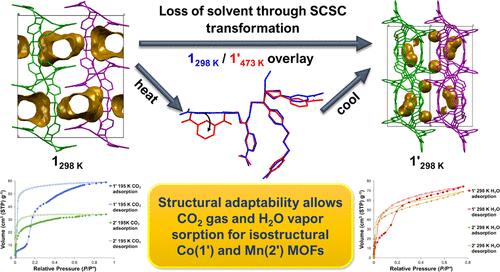Variation in the Sorption Properties of a Pair of Highly Flexible, Isostructural MOFs Exhibiting Single-Crystal-to-Single-Crystal Transformations Rarely Observed in MOFs Based on a Linear Co3/Mn3 Trinuclear Cluster
IF 4.3
3区 材料科学
Q1 ENGINEERING, ELECTRICAL & ELECTRONIC
引用次数: 0
Abstract
Two mixed-ligand metal–organic frameworks (MOFs), [Co3(ia)3(bppdo)(MeOH)]n·n(DMF) (1) and [Mn3(ia)3(bppdo)(MeOH)]n·n(DMF) (2), have been synthesized, where ia = isophthalate, bppdo = 1,3-bis(4-pyridyl)propane-N,N′-dioxide, MeOH = methanol, and DMF = N,N′-dimethylformamide. Single-crystal X-ray diffraction studies reveal that 1 and 2, based on a linear Co3 and Mn3 cluster, respectively, are isoreticular and isostructural and possess two-periodic frameworks consisting of linear trinuclear metal clusters. Variable-temperature single-crystal X-ray diffraction studies confirm single-crystal-to-single-crystal transformations (rarely observed for MOFs based on a linear Co3/Mn3 cluster) upon desolvation and subsequent hydration, despite significant structural changes occurring. The desolvated structures (1′ and 2′) show a drastic reduction in their void spaces (3.7 and 5.7% for 1′ and 2′, respectively, at 298 K) as compared to their as-synthesized structures (potential void spaces of 21.6 and 22.3% for 1 and 2, respectively, at 298 K). Despite the similar void spaces at 195 K that are also seemingly inaccessible, significant CO2 sorption occurs at this temperature for 1′ and 2′, indicating that structural changes had to occur in order to accommodate the adsorbed CO2 molecules. Water vapor sorption at 298 K also induces structural changes in 1′ and 2′ as confirmed by single-crystal X-ray diffraction studies. The structural transformations that occur during desolvation and sorption processes emphasize the remarkable dynamic nature of these frameworks in responding to their environment.

基于线性 Co3/Mn3 三核簇的 MOFs 中罕见的单晶到单晶转变:一对高柔性等结构 MOFs 的吸附特性变化
合成了两种混合配体金属有机框架 (MOF):[Co3(ia)3(bppdo)(MeOH)]n-n(DMF) (1) 和 [Mn3(ia)3(bppdo)(MeOH)]n-n(DMF)(2)、其中 ia = 间苯二甲酸盐,bppdo = 1,3-双(4-吡啶基)丙烷-N,N′-二氧化物,MeOH = 甲醇,DMF = N,N′-二甲基甲酰胺。单晶 X 射线衍射研究表明,1 和 2 分别以线性 Co3 和 Mn3 簇群为基础,呈等线性和等结构,并具有由线性三核金属簇群组成的双周期框架。变温单晶 X 射线衍射研究证实,尽管结构发生了显著变化,但在脱溶和随后的水合过程中,单晶到单晶发生了转变(基于线性 Co3/Mn3 簇的 MOFs 很少观察到这种转变)。与合成前的结构相比(在 298 K 时,1′和 2′的潜在空隙分别为 21.6% 和 22.3%),脱溶结构(1′和 2′)的空隙急剧下降(在 298 K 时,1′和 2′的空隙分别为 3.7% 和 5.7%)。尽管在 195 K 时,1′和 2′也有类似的空隙,似乎也是无法进入的,但在此温度下,1′和 2′发生了显著的二氧化碳吸附,表明结构必须发生变化才能容纳吸附的二氧化碳分子。单晶 X 射线衍射研究证实,水蒸气在 298 K 温度下吸附也会导致 1′和 2′的结构发生变化。在脱溶和吸附过程中发生的结构转变强调了这些框架在响应其环境时的显著动态性质。
本文章由计算机程序翻译,如有差异,请以英文原文为准。
求助全文
约1分钟内获得全文
求助全文

 求助内容:
求助内容: 应助结果提醒方式:
应助结果提醒方式:


